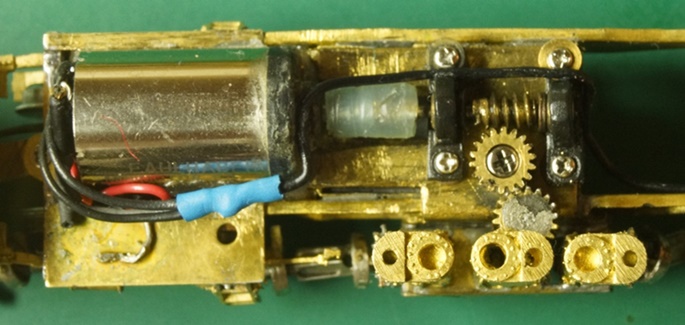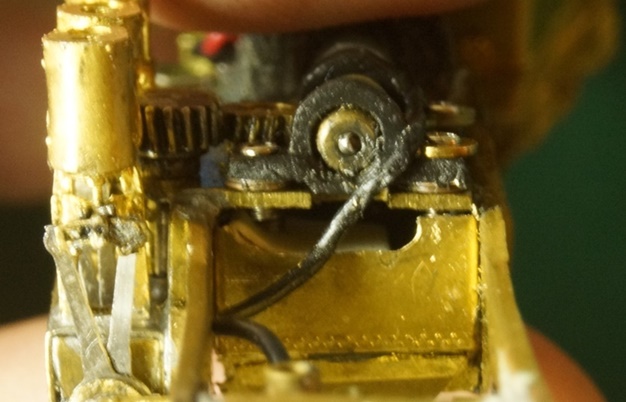

Introduced: 1989
I have never owned one of these, however I'm told by others that the original release had some fairly serious issues (which may explain why they were Overland's first and last N scale steam release). As delivered, most (if not all) of them had failure-prone motors, major problems with derailing, and a propensity for the mechanism to bind and/or seize up. Consequently, OMI issued a full-scale recall, and those that sent their Shays in for repairs received them back with an almost completely redesigned mechanism.
Original version -


As pictured, u-joints connect the motorshaft to the wormshaft. The worm spins a vertical driveshaft which in turn turns one of the axles in the rear truck -

The driven axle then spins the side-rods, which in turn spin the rest of the wheels -

In the redesigned/recall version, the motor and driveshaft are repositioned such that they actually turn the pistons directly, thus spinning the side-rods (and eventually the wheels) -


Although still a bit finicky, I'm told that the redesigned version is much less prone to failure. It also has the added benefit of running significantly slower than the original version. On the down side, the redesigned mechanism is quite a bit noisier than the original version.
I'm told that at one time Keith Wiseman of Wiseman Models sold replacement recall parts (presumably acquired from Overland) for first edition Shays. He also sold OMI Shay "kits" (either unbuilt, partially built, or fully built). Like the recall version, these are purportedly excellent runners.
Disassembling the model for painting purposes is reportedly an extremely daunting task, and definitely not for the faint of heart (or weak of skills). Unfortunately, most (if not all) of them were delivered unpainted.

Prototypically speaking, this model is not particularly useful as a generic Shay - this because the Western Maryland prototype upon which it is based was one of the largest (if not the largest) Shay ever built. Shay fans will probably be better served going with Atlas's mass-manufactured model (one that I can highly recommend) in lieu of this one.
OK, now allow me to turn the podium over to noted N scale locomotive guru Ron Bearden for his thoughts on these models -
I've owned both the original version and a "mostly assembled" Wiseman kit (based on the revised version). All eight wheels on the locomotive
collect current (with current from one rail flowing from the wheels into the chassis and current from the other rail flowing from the wheels into
wired wheelback wipers). The tender truck is electrically neutral, so I added a simple pickup scheme of my own (designed
along the lines of the locomotive trucks). This increased pickup by 50%.
Given the gearing, the first version runs pretty fast. Also, the worm interfaces with the axle gear in such a way that it could
conceivably twist the truck (leading to derailments and other problems).
The revised version is equipped with a Faulhauber coreless motor and is geared much lower than the first version. In fact, it runs right around scale
speeds (the prototype runs at six mph). Yes, you read that correctly. At full throttle, this loco runs at about seven or eight scale mph.
The shell is held in place by two screws. One is located between the front truck and the front coupler (running up through the frame and into the boiler).
The second screw is located under the right cab and is a bit harder to get to (you have to work through the rear truck to unscrew it) -
Due to the all-metal gearing, the second version does generate a bit of "electric razor" racket. And although it does have
the potential to run very smoothly, the internal gears are quite finicky.
As you can see, the motor lays on its side and interfaces with the worm. The worm turns a transition gear which then turns the gear built into the frame behind
the cylinders. The problem is the transition gear and its screw -
Good screw design is "stepped" - with a fat part and a skinny part (like some older tender screws). The fat portion of the
screw "bottoms out", so that no matter how tight you torque it down, it has no effect on what it is securing.
Sadly, this is not the case with the screw that comes with this model. The diameter is uniform from top to bottom (with threads all the way to the end).
Consequently, you cannot get the screw tightened down "just right". The screw needs to be a bit loose relative to the gear (so that said gear can turn).
But with nothing for the screw to bottom out on, the spinning of the gears will
ultimately cause the screw to unscrew itself (thus leading to "fall apart" syndrome). Conversely, if you torque the screw down super tight, the gear will not
turn at all. I did try using Loc-Tite to hold the screw at the desired depth, but given the oiliness of the area, this did not work (even after cleaning).
Didn't OMI notice this? Probably not, because the screw did bottom out (at least at first). The loco has lead poured into the ash pan below the drive
line, and when the loco was new, the transition gear screw would hit the top of the lead (and thus bottom out). However, lead is soft and over time
the screw will eventually burrow down into the lead and become loose.
My simple solution was to use a motor tool to open up the ash pan area so that I could slide a bit of folded business card inside. This gives the
screw something to bottom out on (and thus prevent it from coming loose).
Before -
After -
One minor detail to look for when buying one of these - The generator (located in front of the cab) has a little steam pipe that runs up to it. This little
pipe is very fragile and usually breaks off. The pictures above show models that still have said pipe in place.
Bottom line - These are fantastic (albeit expensive) models, but don't buy one if you're not a tinkerer. And never buy one unless you can see a photo of the
underside (and thus determine if it's "original" or "revised"). The revised version is much more desirable. My grades - the original version is a crapshoot, and the
revised version is a "C" (due to the tuning issues). However, it's pretty close to an "A" if you can get it tuned properly.



Grades: Let's go with Ron's assessment ("F" for the initial release and "C" for the revised version)